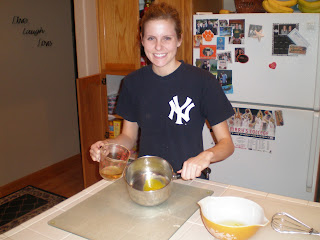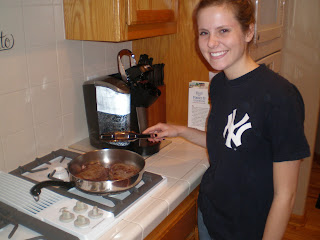The most common types of sauces are oil-and-vinegar salad dressings known as vinaigrettes. Vinaigrettes are a temporary emulsion that is water (vinegar) droplets dispersed in oil. Oil is the continuous phase in vinaigrettes because a thin, mobile sauce is more effective to adhere to vegetable surfaces. It is not important that the dispersed droplets are stabilized because once the sauce is on the lettuce it will be spread out.
Poppy seeds originated from the west Asian plant, Papaver somniferum. This plant's immature seed capsules are also used to collect the latex, opium, which is a mixture of alkaloid drugs. Poppy seeds are harvested from the capsules after latex flow has stopped. Although the poppy seed carries traces of opium and may cause positive results on a drug test, it will not have harmful effects on the body.The poppy seed is about 50% oil by weight and typically have a bitter taste. This taste results from the damage to the seeds, which mixes oil with enzymes and generates free fatty acids. Poppy seeds appear blue to the naked eye, although under the microscope they are actually brown. The illusion of the blue seed is due to the calcium oxalate reflecting blue wavelengths.
The purpose of this recipe is to demonstrate a water-in-oil emulsion and to utilize the poppy seed as a flavoring agent.
Materials:
3 tablespoons sugar
1 1/2 teaspoons finely shredded orange peel
2 tablespoons vinegar
1 tablespoon finely chopped onion
1/3 cup salad oil
1 teaspoon poppy seeds
1 food processor
Methods:
1. Process sugar, orange peel, orange juice, vinegar, onion, and pepper in food processor.
2. With processor running slowly add salad oil in a steady stream until mixture is thickened.
3. Stir in poppy seeds.
4. Shake well before serving.
Results:
1. Process sugar, orange peel, orange juice, vinegar, onion, and pepper in food processor.
2. With processor running slowly add salad oil in a steady stream until mixture is thickened.
3. Stir in poppy seeds.
4. Shake well before serving.
Discussion:
The purpose of this recipe is to demonstrate a water-in-oil emulsion and to utilize the poppy seed as a flavoring agent. The emulsion was successful in which the water completely dispersed in the oil. The oil was slowly added to ensure proper emulsion would occur. Although the emulsion was only temporary, it could be easily shaken to retain the same consistency. Also the poppy seed added a bitter taste in order to balance the orange rind flavor. Overall the recipe was very simple to make and was cost-effective compared to regular salad dressing. In the future I would experiment with different types of vinaigrettes by changing the types of oil and vinegar used.
Citation:
Darling, Jennifer. New Cook Book. Des Moines, IA: Meredith, 2002. Print.





































